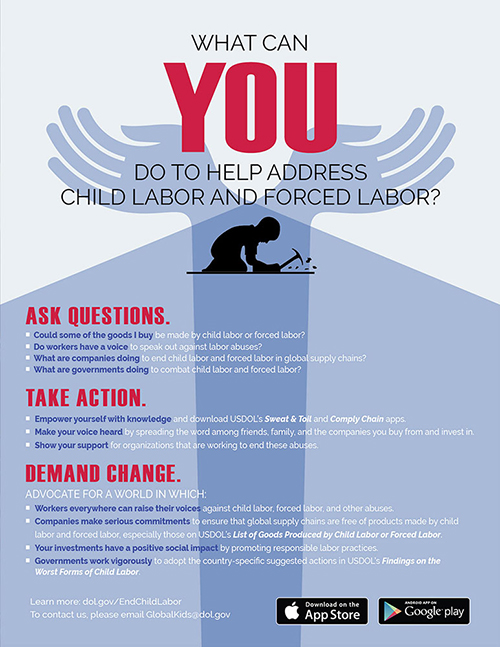List of Goods Produced by Child Labor or Forced Labor
The Bureau of International Labor Affairs (ILAB) maintains a list of goods and their source countries which it has reason to believe are produced by child labor or forced labor in violation of international standards, as required under the Trafficking Victims Protection Reauthorization Act (TVPRA) of 2005 and subsequent reauthorizations. The List of Goods Produced by Child Labor or Forced Labor comprises 159 goods from 78 countries and areas, as of September 28, 2022.
ILAB maintains the List primarily to raise public awareness about forced labor and child labor around the world and to promote efforts to combat them; it is not intended to be punitive, but rather to serve as a catalyst for more strategic and focused coordination and collaboration among those working to address these problems.
Publication of the List has resulted in new opportunities for ILAB to engage with foreign governments to combat forced labor and child labor. It is also a valuable resource for researchers, advocacy organizations and companies wishing to carry out risk assessments and engage in due diligence on labor rights in their supply chains.
The countries on the List span every region of the world. The most common agricultural goods listed are sugarcane, cotton, coffee, tobacco, cattle, rice, and fish. In the manufacturing sector, bricks, garments, textiles, footwear, carpets, and fireworks appear most frequently. In mined or quarried goods, gold, coal and diamonds are most common.
ILAB published the initial TVPRA List in 2009 and updated it annually through 2014, following a set of procedural guidelines that were the product of an intensive public consultation process. ILAB now updates and publishes the List every other year, pursuant to changes in the law.
Procedural Guidelines
On January 25, 2024, ILAB's Office of Child Labor, Forced Labor, and Human Trafficking published Procedural Guidelines for the development and maintenance of the List of Goods from countries produced by child labor or forced labor in violation of international standards.
| Country/Area | Good | Exploitation Type |
|---|---|---|
| Colombia | Child Labor | |
| Colombia | Child Labor | |
| Colombia | There are reports that children in Colombia as young as 11 years old are forced to cultivate and pick coca, and to scrape coca leaves. The Government, NGOs, media, and the ILO indicate that some children are forcibly recruited by non-state armed groups, such as the Revolutionary Armed Forces of Colombia, the National Liberation Army, and criminal groups to pick coca. Others are forced by drug traffickers. Criminal and illegal armed groups use threats of torture or death to prevent children from attempting to escape. |
Child Labor, Forced Labor |
| Colombia | Child Labor | |
| Colombia | Child Labor | |
| Colombia | There is evidence that children between the ages of 5 and 14 work in the harvesting and production of pome and stone fruits in Colombia. Based on an analysis of the Colombia Great Household Survey – Child Labor Module, an estimated 10,679 children under the minimum age for work are involved in child labor in pome and stone fruits. The release of this survey demonstrates the Government of Colombia’s commitment to addressing child labor and its acknowledgment that data collection is vital to the design and implementation of sound policies and programs. |
Child Labor |
| Colombia | Child Labor | |
| Colombia | There is evidence that children between the ages of 5 and 14 work in the harvesting and production of grapes in Colombia. Based on an analysis of the Colombia Great Household Survey – Child Labor Module, an estimated 31,834 children under the minimum age for work are involved in child labor in the harvesting and production of grapes. The release of this survey demonstrates the Government of Colombia’s commitment to addressing child labor and its acknowledgment that data collection is vital to the design and implementation of sound policies and programs. |
Child Labor |
| Colombia | Child Labor | |
| Colombia | Child Labor |
your hand? Download ILAB's Sweat & Toil App today!
Are you a company looking to fight child labor and forced labor in supply
chains?





